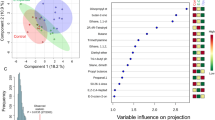Abstract
To study the supplementary effect of Spirulina, pregnant rats were fed 5 different kinds of diets (casein, Spirulina, wheat gluten, Spirulina + wheat gluten, Spirulina-without additional vitamins and minerals), each providing 22% protein during the period of pregnancy. The outcome of pregnancy was assessed from litter and dams' weight and litter size. Maternal weight gain was found to be maximum with Spirulina + wheat gluten and least with the wheat gluten diet. Rats receiving Spirulina containing diets produced significantly (p<0.05) higher litter size than those receiving casein and wheat gluten. In spite of having higher litter size, Spirulina containing diet groups produced pups with birth weights comparable to those of casein. Spirulina appears to be a good dietary supplement during pregnancy.
Similar content being viewed by others
References
Ciferri O (1983) Spirulina, the edible microorganism. Microbiol Rev 47: 551–578
Liener IE (1972) Nutritional value of food protein products. In: K Smith and SD Circle (eds) Soybean Chemistry and Technology. Vol. 1. Proteins, West-Port, Conn: AVI Publishing Company, p. 203
Venkataraman LV (1983) Blue-green Alga-Spirulina platensis. Mysore: Central Food Technolocal Research Institute, pp. 15–18.
Venkataraman LV, Becker EW (1985) Biotechnology and Utilization of Algae — The Indian Experience. Delhi and Mysore: Department of Science and Technology and Central Food Technological Research Institute, pp. 100–104
AOAC (1980) Official Methods of Analysis, Horwitzw (ed). Washington, D.C.: Association of Official Analytical Chemists, pp. 211–214
Lindsay WL, Norvell MA (1969) A new DTPA-PEA soil test for zinc and iron. Agron Abstr 61: 84
Raghuramulu N, Nair KM, Kalyanasundra S (1983) A Manual of Laboratory Techniques. Hyderabad: National Institute of Nutrition, pp. 29–130
Sampson DA, Hunsaker HA, Jansen GR (1986) Dietary protein quality, protein quantity and food intake: Effects on lactation and on protein synthesis and tissue composition in mammary tissue and liver in rats. J Ntr 116: 365–375
Grigor MR, Allan JE, Carrington JM, Carne A, Geursen A, Young D, Thompson MP, Haynes EB, Coleman RA (1987) Effect of dietary protein and food restriction on milk production and composition, maternal tissues and enzymes in lactating rats. J Nutr 117: 1247–1258
Tipnis HP, Pratt R (1960) Protein and lipid content ofChlorella vulgaris in relation to light. Nature 188: 1031–1032.
Becker EW (1984) Biotechnology and exploitation of the green algaScenedesmus oblibuus in India. Biomass 4: 1
Becker EW, Venkataraman LV (1984) Production and utilization of the blue-green alga Spirulina in India. Biomass 4: 105–125
Hsueh AM, Simonson M, Chow BF (1975) Effect of protein quality in the maternal diet on reproduction and development of progeny. Proc 9th Int Congr Nutr 2: 37–43
Jansen GR, Monte WC (1977) Amino acid fortification of bread fed at varying levels during gestation and lactation in rats. J Nutr 107: 300–309
Hesby JH, Conrad JH, Plumlee MP, Harrington RB (1972) Effects of normal corn and opaque-2 corn diets on serum proteins and reproductive performance of gravid swine. J Anim Sci 34: 974–978.
Niiyama Y, Kishi K, Endo S, Inoue G (1973) Effect of diets devoid of one essential amino acid on pregnancy in rats maintained by ovarian steroids. J Nutr 103: 207–212
Stapleton P, Hill DC (1980) The effect of maternal dietary lysine and methionine levels on pregnancy and lactation in rat. Nutr Rep Int 21: 231–242.
Jansen GR, Grayson C, Hunsaker H (1987) Wheat gluten during pregnancy and lactation: effects on mammary gland development and pup viability. Am J Clin Nutr 46: 250–257.
Durand-Chastel H (1980) Production and use of Spirulina in Mexico. In: Shelef G, Soeder CJ (eds) Algae Biomass. North-Holland: Biomedical Press, p. 51
Williams SR (1989) Nutrition and Diet Therapy. Boston: Mosby College Publishing, p. 212
Author information
Authors and Affiliations
Rights and permissions
About this article
Cite this article
Kapoor, R., Mehta, U. Effect of supplementation of blue green alga (Spirulina) on outcome of pregnancy in rats. Plant Food Hum Nutr 43, 29–35 (1993). https://doi.org/10.1007/BF01088093
Received:
Accepted:
Issue Date:
DOI: https://doi.org/10.1007/BF01088093




